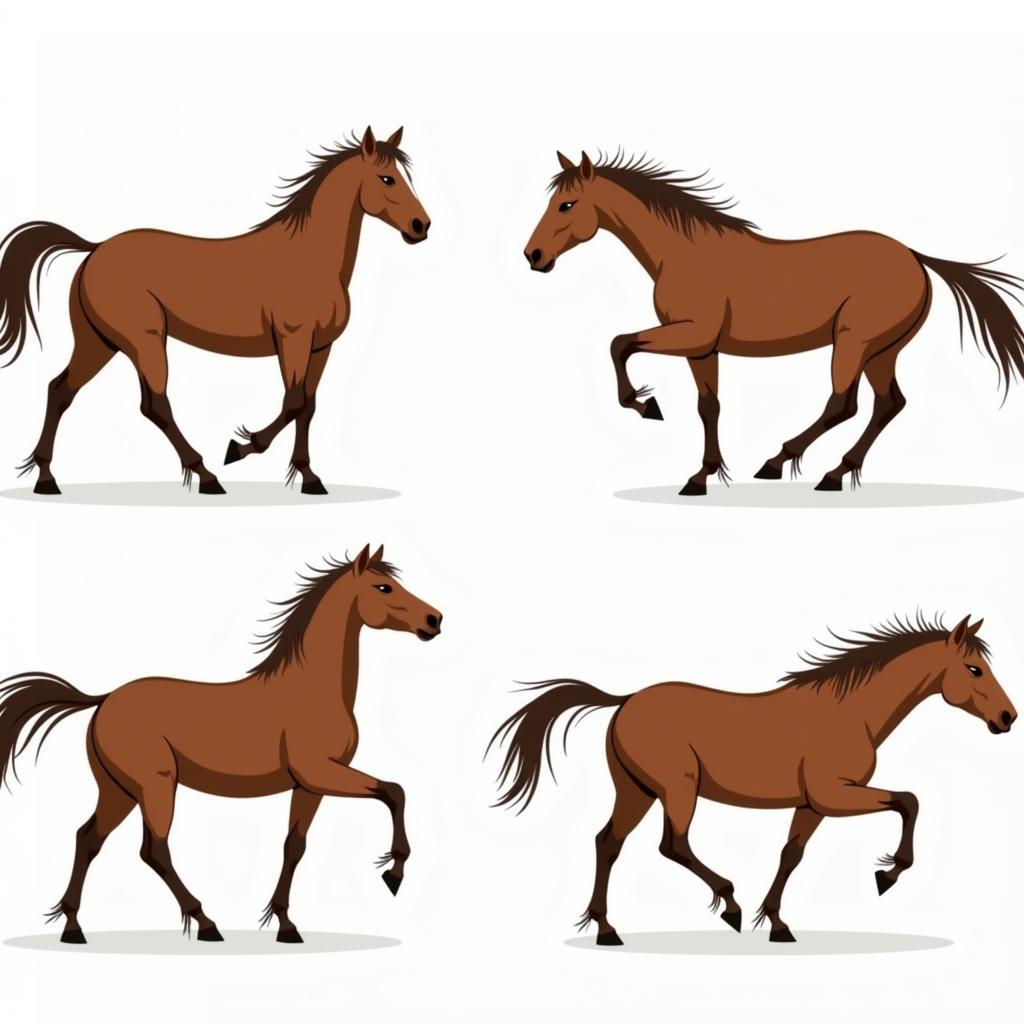Lameness in the hind legs of horses can be a subtle issue or a glaring problem, but regardless of severity, it demands attention. This article will delve into the complexities of hind leg lameness in horses, exploring the causes, symptoms, diagnosis, and treatment options available. We’ll equip you with the knowledge to recognize potential problems and ensure your equine companion receives the best possible care.
Common Causes of Hind Leg Lameness in Horses
Hind limb lameness can stem from a variety of sources, ranging from minor strains to more serious conditions. Identifying the underlying cause is crucial for effective treatment. Some common culprits include:
- Hock Problems: The hock is a complex joint and a frequent site of lameness. Osteoarthritis, bone spavin, and bog spavin are just a few examples of hock-related issues. hock injections for horses can sometimes be a helpful treatment option.
- Soft Tissue Injuries: Strains, sprains, and tears in muscles, tendons, and ligaments can occur in the hind limbs, often due to overuse, trauma, or improper footing. A hind leg horse tendon injury pictures resource can help you visually identify some common tendon injuries.
- Foot Problems: Conditions like abscesses, navicular syndrome, and cracks in the hoof wall can also cause lameness, sometimes manifesting in the hind limbs.
- Stifle Issues: The stifle, akin to a human knee, can be affected by various problems, including upward fixation of the patella and meniscal tears.
- Traumatic Injuries: Kicks from other horses, falls, and other accidents can lead to fractures, dislocations, and other injuries resulting in lameness. Understanding how a horse kicks another horse can help prevent such injuries.
Recognizing the Symptoms: Is Your Horse Lame?
 Symptoms of Hind Leg Lameness in a Horse
Symptoms of Hind Leg Lameness in a Horse
While some lameness is obvious, subtle signs can easily be missed. Careful observation is key to early detection. Look for:
- Head Bobbing: A horse may bob its head up and down when the lame leg hits the ground, trying to shift weight off the affected limb.
- Uneven Gait: Notice any asymmetry in the horse’s stride. Does one hind leg appear to move differently than the other?
- Reluctance to Move: Is the horse hesitant to move, turn, or perform certain maneuvers?
- Swelling or Heat: Check the legs for any visible swelling, heat, or sensitivity to touch.
Why is Early Diagnosis Important?
Early diagnosis of lameness in the hind legs of horses is critical for several reasons. Early intervention can prevent the condition from worsening, potentially minimizing long-term damage and promoting a quicker recovery. Additionally, early treatment can often be less invasive and more cost-effective than addressing advanced stages of the problem.
“Early diagnosis is essential. The sooner you address lameness, the better the chances of a full recovery.” – Dr. Emily Carter, Equine Veterinarian.
Diagnosing Lameness in Horses
Diagnosing the specific cause of lameness requires a thorough veterinary examination. This typically involves:
- Visual Observation: Assessing the horse’s gait at a walk and trot.
- Palpation: Feeling the legs for any abnormalities in temperature, swelling, or pain response.
- Flexion Tests: Manipulating the joints to identify areas of discomfort.
- Diagnostic Imaging: X-rays, ultrasounds, or MRI scans may be necessary to visualize internal structures and pinpoint the problem.
Treatment Options for Hind Leg Lameness
Treatment for Lameness In Hind Legs Of Horses varies depending on the underlying cause. Options include:
- Rest and Restricted Activity: Often the first step, allowing the injury to heal.
- Medications: Anti-inflammatories, pain relievers, and joint supplements. sudden lameness in horse front leg can also benefit from similar treatments.
- Therapeutic Shoeing: Specialized shoes or pads can provide support and alleviate pressure on affected areas.
- Surgery: In some cases, surgical intervention may be required to repair damaged tissues or correct structural abnormalities.
- Rehabilitation: Physical therapy, including controlled exercise and stretching, can aid in recovery and restore function. Consider incorporating bell horses into your rehabilitation program for gentle exercise.
Conclusion: Taking Action Against Hind Leg Lameness
Lameness in the hind legs of horses is a significant concern that requires prompt attention. By understanding the common causes, recognizing the symptoms, and seeking appropriate veterinary care, you can help your horse regain soundness and enjoy a healthy, active life. Early intervention is key to a successful outcome.
Frequently Asked Questions about Hind Leg Lameness in Horses:
When should I call the vet for lameness?
What are the long-term effects of untreated lameness?
Can lameness be prevented?
How can I manage pain in my lame horse?
What is the recovery time for hind leg lameness?
What are some alternative therapies for lameness?
Is lameness always a sign of a serious problem?
Need more help? Contact us! Phone: 0772127271, Email: [email protected] or visit us at QGM2+WX2, Vị Trung, Vị Thuỷ, Hậu Giang, Việt Nam. We have a 24/7 customer service team ready to assist you.